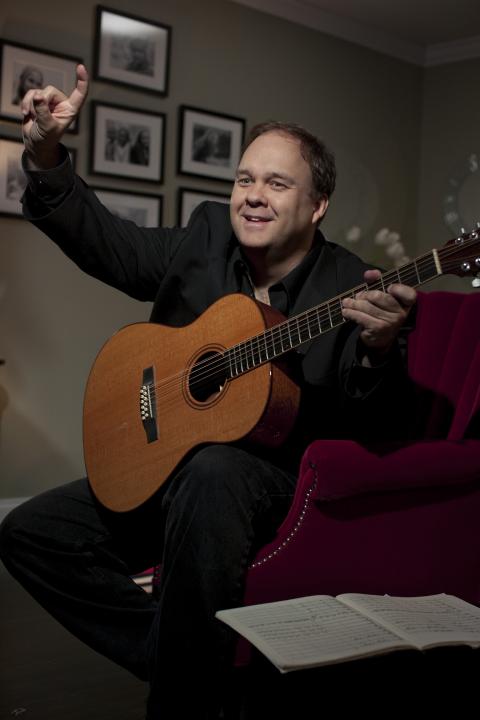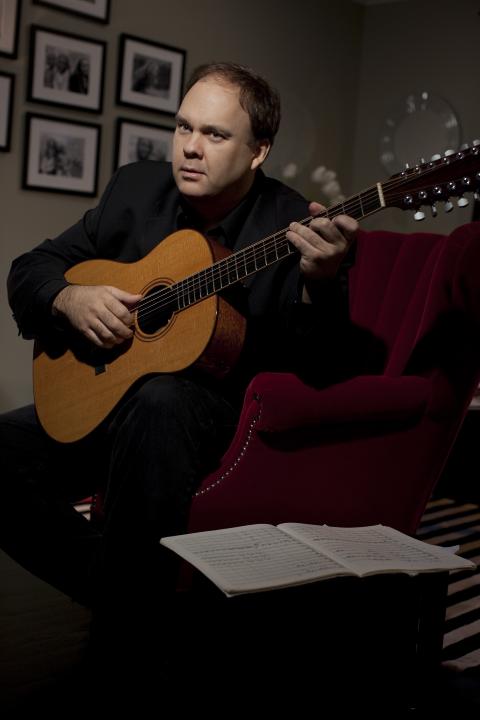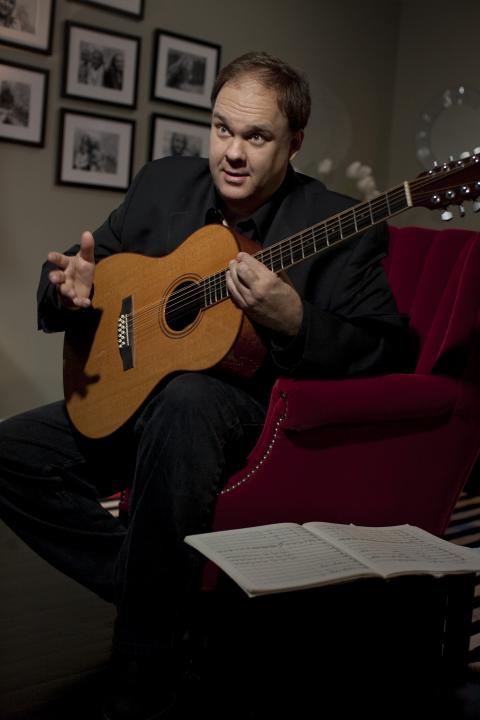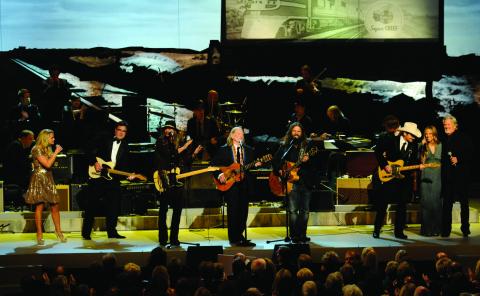A Juxtaposition of Two Worlds

Rob Mathes '84
Jimmy Katz

Rob Mathes '84
Jimmy Katz

Rob Mathes '84
Jimmy Katz

At the December 2010 Kennedy Center Honors TV broadcast, Rob Mathes (far left) served as music director, and played piano for an array of stars. Front row, from the left: Miranda Lambert, Vince Gill, Kid Rock, Willie Nelson, Jamey Johnson, Brad Paisley, Sheryl Crow, and Kris Kristofferson.
Jeffrey Staab
Watching Rob Mathes direct an orchestra, choir, and rhythm section comprising some of New York’s top vocalists and instrumentalists is an exhibition of grace under pressure. After only a few moments, it becomes readily apparent why he gets calls to write orchestral charts for projects such as Sting’s Symphonicity CD and tour and to serve as the music director for such superstar extravaganzas as the “We Are One: Obama Inauguration Celebration” at the Lincoln Memorial. Mathes is affable but clearly in command of the 100-plus musicians working on a huge program of r&b and gospel-flavored songs he’s written and orchestrated for an ambitious concert scheduled for the following night.
As they run the tunes, Mathes offers the performers suggestions to bring the music closer to his perfectionist vision. At various points, he encourages the cellist to take more time in the phrasing of his solo and asks the drummer to pull the tempo back one metronome marking and hold it there. Then later he checks with the sound tech on the progress he’s made to eliminate an elusive midrange feedback in the house system. But in addition to capably managing all these details, Mathes is the main singer in a concert that will draw a standing-room-only crowd to Christ Church in Greenwich, Connecticut, the town where Mathes grew up.
Few, if any, of Mathes’s peers in the music industry have a similar diversity of skills and mastery of styles. In addition to his music directing and orchestrating talents, Mathes is a triple-threat performer. He’s got an instantly appealing tenor voice as well as rock-solid piano and guitar chops. He’s cowritten with some of Nashville’s top songwriters and had titles from his catalog recorded by Rascal Flatts, Bonnie Raitt, Aaron Neville, Wynonna Judd, and Vanessa Williams, to name a few.
The range and depth of his musical skills and his ability to move between far-flung styles has been the cornerstone of his career. Over the past 25 years, Mathes has written charts for such disparate artists as Carly Simon, Rod Stewart, Vanessa Carlton, Panic! at the Disco, Yo-Yo Ma, Michael McDonald, Lou Reed, Luciano Pavarotti, Ray Charles, and scores more. Not long after leaving Berklee, Mathes toured as a guitarist and keyboardist for trumpeter Chuck Mangione and used the funds he earned to sharpen his songwriting and studio production skills by recording reams of his own material. While many figures in the industry have noted his gifts over the years, Mathes gives special credit to fellow producers David Foster and Phil Ramone for helping him reach such career heights.
It should be noted that, even with his numerous achievements in the pop music world, Mathes is also completely at home in the classical world. Conductor Leonard Slatkin commissioned Mathes to write concert works for both the Los Angeles Philharmonic and Nashville Symphony orchestras. Years of post-Berklee composition studies helped Mathes to refine his writing skills. Today, whenever he packs his bags for gigs in other cities, he always brings the scores to Stravinsky’s Violin Concerto in D and Mahler’s Symphony No. 6. He has studied the life and works of these particular composers for decades. Mathes maintains that by juxtaposing the classical and pop-music worlds, his writing has a distinctive voice. His two recent CDs, the r&b-flavored Evening Train and the double CD set Orchestral Songs amply showcase that voice.
Despite all the energy Mathes devotes to making others’ music sound great, he’s continually writing and recording his own songs. His frequent advice to young musicians is “Make your own stuff and impose deadlines on yourself that you can’t break.” Mathes lives by this maxim and has created a body of work that is the lifeblood of his artistry. “I am a songwriter and composer and will write until the day I die,” he says. “If I stopped writing songs, my orchestrations wouldn’t be any good. I would be useless to someone like Sting.” Perhaps “useless,” is an overstatement, but the thought reveals a work ethic that has served Mathes well.
You grew up in a home where classical music was paramount, but you also pursued pop music and songwriting. How did these interests start to intertwine for you?
Both of my parents, my mother’s twin sister, and her husband all studied music at Yale. My mother has consistently taught between 50 to 60 piano students for the past 50 years; my dad was a clarinetist; my aunt Joyce played bassoon with the New York City Opera; and her husband studied composition with Paul Hindemith and played trombone in big bands and wrote arrangements. One of my grandfathers was a songwriter. Even though my dad was a classical musician, he listened to Dylan records.
So I had a lot of different music around me. To some, my music might seem really eclectic, but it doesn’t seem like style jumping to me to have a piece that goes from a Bach-like cello part into a hymn with an r&b feel. I’m just trying to be a creative musician.
Was piano your first instrument?
Yes. I was playing things at the piano when I was two or three, and my mother taught me from the John Thompson books. But I would always have her play the piece I was supposed to learn. I would memorize it and not really read the music. Then she caught me, so I didn’t really read music until I was about seven. I would also figure out the chords to songs and try to use them in songs I wrote. After my family moved from East Providence, Rhode Island, to Greenwich, Connecticut, my parents took me to [jazz pianist] John Mehegan, a Juilliard faculty member, and he taught me a lot of music theory.
When did you take up guitar?
I had been playing Bach and Beethoven on the piano. My mother was tough on me with the piano, and I’m thankful for that. But my parents also bought me at guitar when I was 13. My principal instrument at Berklee was guitar. Later on I went back to piano, which was really important to me when I started doing classical orchestration.
What were your aspirations when you came to Berklee?
First of all, Berklee was the only college I wanted to go to when I was in high school. In addition to what I was getting in my classes, one incident in February of 1982 was pivotal in my development. I went to the Berklee library and asked for John Coltrane’s Impressions album. They only had reel-to-reel tapes in the library back then. I gave the catalog number and got the box. I put it on, but it wasn’t Coltrane, I didn’t know then, but it was Mahler’s sixth symphony, and I was transfixed by it. The harmony was extraordinary. I’d never heard Mahler before. I was hearing late–Romantic era harmony spiced with Bach-style polyphony.
I’d been obsessed with Stevie Wonder and Steely Dan at the time, and I was studying at a school that taught improvisation and scale relationships within vertical harmony. Jazz teaches you to play horizontally around vertical structures. In classical music, the tradition is to write lines that end up in vertical harmonic structures. So I listened to the whole tape of the symphony and then went up and asked what I had been listening to. The librarian apologized and told me that it was Mahler’s sixth. That music really changed my life. I started listening more and more to classical music. I discovered Leonard Bernstein conducting Mahler, which is like standing at the tomb on Easter morning! I looked through my parents’ record collection and found a recording of Mahler songs. I wanted to know, what was this harmony? I went out and bought the music so I could learn the songs.
In the middle of your studies, you took some time off. What did you do in the intervening years?
I would have stayed at Berklee longer, but after my first year, I was hooked up with a guy who was an assistant to [jazz pianist and composer] Bob James. He was a keyboard player named Doug Winters, and we had a band called the Mathes-Winters Band. I had written some songs with Doug, and Bob loved the material. He told me that if I left school for a while, he would get us a deal with CBS, so I left.
Bob had some real power at CBS then. But when the contract came and I went over it with a lawyer, they were going to own me for 10 years, so I didn’t sign it. I put a band together and went to play around the Houston area for about four months. I was writing a lot of songs, but the classical bug was really beginning to set in on me. I knew I wasn’t going to become a pop star.
I wanted to go back to Berklee and take more courses on harmony and big-band writing and work again with [faculty members] Donnie Nolan, Greg Hopkins, and Ken Pullig. So I returned for another year and got a good dose of Berklee. I left the second time on specific advice from my uncle. It’s not advice I’d give to my kids today, though, because I think having a degree is really important.
My uncle said he could see that classical music was really getting me, and he asked what I thought I wanted to do. I told him I had to understand how [classical] music worked. I felt I had some good songs in me, but maybe they were part of the larger structure. The music I was closest to then was the Mahler song cycles and Benjamin Britten’s song cycles. I could see a future for myself writing song cycles. I could do a gospel or r&b thing with a rhythm section; I can groove. So I felt I could find myself through songs and rich orchestration.
My uncle recommended that I figure things out by studying with a teacher one on one. So I started studying privately with Myron Fink, who taught at a few colleges in New York. He really knew orchestration and counterpoint and never wrote music near a piano. He could just look at my score and say, “This won’t work. You’ve got the flute in a range where it won’t be heard because of the range you’ve got oboe playing in.” Studying with him for three or four years changed my life and led to me writing string arrangements. But all during that time, I was playing with my band and writing songs.
How did you end up playing with Chuck Mangione?
In the late ’80s, I was playing in a club with a band that had horn players Andy Snitzer, Jeff Kivet, Chris Botti, and others who went on to have great success. Chuck came in one night and heard me playing guitar and singing. That led to me going on the road with him playing guitar and keyboards. I did that for about four years and spent every penny I earned with Chuck in the studio recording my songs. That essentially created my career by giving me lots of experience recording and producing my own stuff.
Toward the end of my time with Chuck, Leonard Bernstein was re-recording the Mahler symphonies and performing them with the Vienna Philharmonic. In 1988 he was going to do the Mahler sixth at Carnegie Hall. I looked up the dates, and I had gigs with Chuck. I called Chuck’s office to see if I could get out of the gigs, but the answer was no. So I called Bernstein’s office to find out if there were any more performances scheduled in other cities. The lady on the phone told me that Bernstein and the orchestra would play the piece on their tour of Israel. I was free on the date of their concert in Tel Aviv. So I saved my money and told my mother and aunt that we were all going over there.
To this day, I say hearing Bernstein play Mahler’s sixth was the greatest musical experience of my life. After the concert, I went to the green room to meet him. I told him I had come from Connecticut just to see him conduct Mahler. He said, “Get over here!” and gave me a big hug. For the rest of his life, I was always allowed into the green room after his concerts.
How did pop and country artists come to start recording your songs?
Around 1992, I was working in a studio recording my Christmas song cycle called William the Angel. A guy named Joe Ferry was there, and he was putting a Christmas compilation album together that had Dr. John, the Roches, and some other people on it.
He loved one of my songs called “Good News,” and he put it on the album. Kathy Mattea is a Roches fan, and she bought the album. She liked my song so much that she recorded it, and it became the title track of her album that later won a Grammy. That was really the first door that opened for me.
A few years later, trumpet player Jeff Kivet passed along a copy of my recording of the song cycle to Vanessa Williams. She fell in love with the song “Star Bright” and made that the title track of her Christmas record. She asked Jeff who had arranged the music, and that led to me writing half the arrangements for her record. Phil Ramone heard those arrangements and hired me to work on the Pavarotti & Friends concerts.
You’ve had a great blend of musical endeavors in your career.
If you think about it, without my Berklee experience and the pop and jazz foundation in my music, none of this would have happened. The classical background has given me my voice, but it is the juxtaposition of the two worlds that has made what I do unique. I couldn’t compete with [classical composer] Thomas Adès in writing a trenchant and important contemporary classical piece that expands the musical language. But writing a song with good melody, playing with a rhythm section, and writing an orchestration that has some felicity and invention is a rare thing. The model of someone who is a rhythm section player and understands pop and rock as well as Stravinsky’s Violin Concerto is unusual. It’s a little world I’ve created for myself.
How did you become the music director for events such as the Kennedy Center Honors series and the Obama Inaugural Celebration?
Michael Stevens is the director of the Kennedy Center Honors series. Phil Ramone, who has done so much for my career, introduced me to Michael’s wife, Ali Gifford, and she introduced me to Michael. My first year doing that show was 2003, when we honored James Brown and Loretta Lynn. I wrote a massive chart on “Georgia on My Mind” for [gospel singer] Yolanda Adams with strings, horns, and a 200-voice choir. Michael was thrilled with it, and we’ve been like family ever since. He called me to do the Obama concert at the Lincoln Monument. Michael also directed the movie Thurgood, about Justice Thurgood Marshall, and I got the call to write the score.
What’s most important when approaching the high-profile gigs you do?
You have to make sure you do your best work no matter who you are doing it for. Your work will speak for you. If you bring your best to everything you do, one of those things can turn into something and be a messenger for you. My work for Michael Stevens turned into a messenger for me.
How did you come to work with Sting?
I think Chris Botti originally told him about me. Sting and I have met a few times over the years. I direct the music for the Songwriters Hall of Fame each year, and we honored Sting a few years ago. I was the orchestrator and music director for some of the Pavarotti & Friends concerts, and Sting was part of those productions one year.
How collaborative were the orchestrations you wrote for his Symphonicity CD?
When I got the call from Sting’s manager, I told her I couldn’t just write charts and send them in. I’d have to meet with Sting and talk about the logistics because his music means too much to me. Back when I was playing in clubs, I used to sing some of his songs. I didn’t want him to just tell me to go for it.
When I saw him at the Kennedy Center Honors in 2009, I gave him my thoughts on some of the charts others had written for a concert he did with the Chicago Symphony Orchestra. I described my approach and said I’d write charts for a suite and record it so he’d know what I was hearing. I told him that I’d do the charts, pay for the copying, and my travel to Abbey Road Studios if he would pay for the sessions and the musicians. It would be an expensive demo, but I told him that I knew he’d like it. He said, “I like your fire; let’s do it.” The demo included “King of Pain,“ “Every Little Thing She Does Is Magic,” “Roxanne,” and “Why Should I Cry for You?” From those first sessions, “Every Little Thing She Does Is Magic” and “Roxanne” are on the record; the others are in his live show. After he heard the arrangements, he wanted me to be the music director for the project.
What are you currently working on?
I am producing more records these days. I just produced one for Bettye LaVette. She’s the closest thing we have—other than Aretha—to a soul legend with the power and artistry of an Otis Redding. In addition to Sting’s Symphonicity CD, I did his [forthcoming] Live in Berlin DVD/CD set. I’ve produced three Vanessa Williams projects and projects for Rod Stewart, Carly Simon, and a guy from the show Glee.
What would you list among highlights from your career?
I’d say playing piano for Al Green when he sang “Amazing Grace” for the 9/11 tribute in 2002 was astonishing. I’ll never forget it. Playing piano and leading the band for Bono and the Edge on their version of Cole Porter’s “Night And Day” for Bono’s MusiCares tribute was ferocious. I’d also have to list playing rhythm guitar for Eric Clapton on “Stormy Monday” and for Elton John on “I Guess That’s Why They Call It the Blues.” Arranging and playing “It’s a Man’s World” for James Brown and Pavarotti is also up there. I told James Brown that people have always spoken of the three Bs as Bach, Beethoven, and Brahms, but to me it’s Bach, Beethoven, and Brown. He loved that.
Do you prefer to be thought of as a songwriter or a composer?
The word composer means more to me. In my view, the difference between a composer and a songwriter is that a songwriter is often limited by a language, a point of view, and song form, and a composer isn’t. When I was younger, before I really learned counterpoint, harmony, and orchestration, I was a prisoner of my fingers and what they stumbled on. I will never forget discovering one day—to my horror—that in everything I’d written, I tended to start my melodies on the fifth of the scale, never on the downbeat of the measure, and that I used only about three different tempos.
Once I heard Mahler and Ellington, I was determined to be in control of my elements. Yet, at the end of the day, I write music that is inherently vocal in its inspiration. I collect volumes and volumes of poetry. Joni Mitchell, Leonard Cohen, and Bob Dylan are the writers that have given me the most inspiration lyrically. Working within the smaller, more detailed form, even as it affects a larger whole, is what interests me. There are great composers out there like John Corigliano, Thomas Adès, Jonathan Harvey, George Benjamin, and others who write brilliant large-scale works that carry the Stravinsky and Mahler torches. The rest of us must make do with smaller, more reachable goals: making a lovely garden out of small, refined materials.
All any composer can do is try to be faithful to the materials at hand and fulfill some artistic purpose in [his] work. One hundred years later, so many composers are still cursed by the Rite of Spring. Forty years later, pop musicians are cursed by the Sgt. Pepper’s Lonely Hearts Club Band album. Jazz musicians are cursed by the career of Miles Davis. We don’t know what to do, and it’s not a matter of “How can we improve on these?”
Kind of Blue [by Miles Davis] was a sudden convergence of elements that’s not going to happen again. CBS was being led by Goddard Lieberson, who used money generated by rock artists on the label to produce a beautiful jazz masterpiece. He promoted it, and it sold 2 million copies.
The Beatles owned the world—not from writing songs like “A Day in the Life” but by having mop tops and writing songs like “She Loves You.” In 1967, they had the world at their feet and could do anything they wanted in the studio. In addition to their great talent, they had George Martin producing them. It was a perfect storm.
Stravinsky was an angry Russian kid who learned all the tricks from [Nikolay] Rimsky-Korsakov, and had already written a symphony and The Firebird. He had all this invention in him. He also had the support of the [ballet] impresario Sergei Diaghilev. He went to an apartment in Sweden, dreamed up The Rite of Spring, and changed music history forever.
Today all of us are trying to make good on that. What are we to do? We’re just supposed to do the best we can and put it out there.




